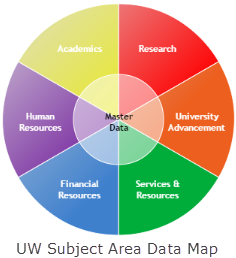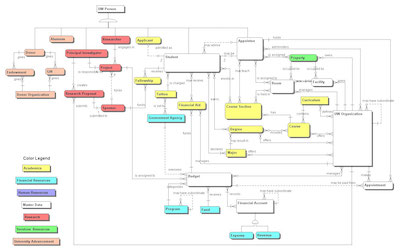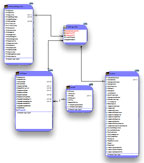The following models represent the views of the University of Washington’s data, starting with a high-level, University-wide view in the Data Map, down to table and column-level detail in the Enterprise Data Warehouse (EDW) Physical Models. From conceptual, to logical, to physical views, our data models help UW link key business processes with actual data structures.
UW Data Map

The UW Data Map is the highest-level data model, representing a data and business process classification scheme. The Data Map provides consistency in the cataloging and maintenance of institutional data contained within a broad spectrum of systems.
Conceptual Model

The Conceptual Model breaks down the Data Map into the University’s major business concepts and their relationships to one another. The Conceptual Model is based on input from business stakeholders and is managed by the Enterprise Data Warehouse (EDW) Information Architect. Consumers of the Conceptual Model include Data Custodians, the DMC, the Information Architect, data modelers and those involved with University source data systems.
The EDW Conceptual Model is currently being updated and is not available at this time. If you are seeking specific information regarding the conceptual model please contact edw-help@uw.edu.
EDW Physical Models

The physical data models contain all the details of the data structures in the EDW, including table names, column names, data types, key values, and relationship information. EDW Physical Models are managed by the EDW Data Modeler. Consumers of the Physical Models include analysts, Business Intelligence tool builders, and Data Custodians.
EDW Physical Models are currently being updated and are not available at this time. If you are seeking specific information regarding an EDW database model, please contact edw-help@uw.edu.
